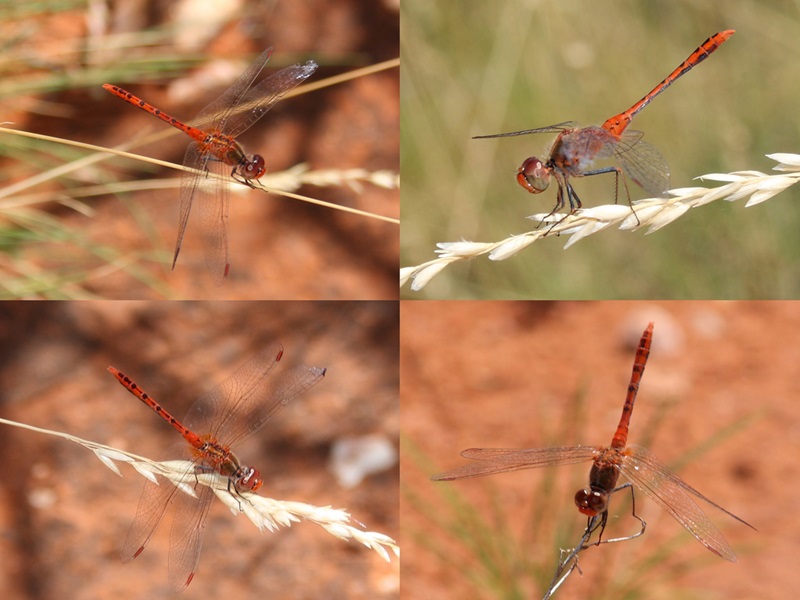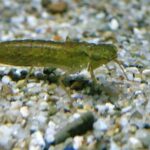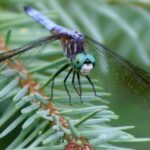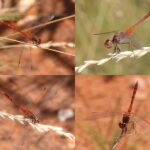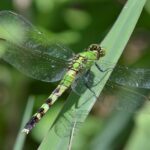The Red Dragonfly, also known as the Red-Veined Darter or Nomad, is scientifically classified as Sympetrum fonscolombii and belongs to the Sympetrum genus. It is widespread across southern Europe, and since the 1990s, it has also established itself in northwestern Europe, including Ireland and Britain. Behavioral observations and genetic analyses suggest that this species exhibits significant divergence from others within the same genus and may eventually be reclassified.
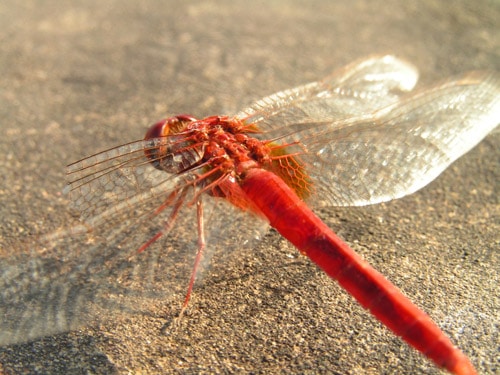
Description
A typical Red Dragonfly measures approximately 4 cm in length with a wingspan of about 6 cm. Males are distinguished by their vivid red abdomens, which are notably brighter than those of other Sympetrum species. Their wings feature striking red veins, while the hindwings have a yellowish tinge at the base. The pterostigma of this species is often pale, bordered by a black vein, and the underside of the eyes bears a bluish-gray hue. Females, in contrast, display yellow-veined wings and a yellowish abdomen. The legs of both sexes exhibit alternating black and yellow markings. Juveniles resemble females but develop a redder hue as they mature.
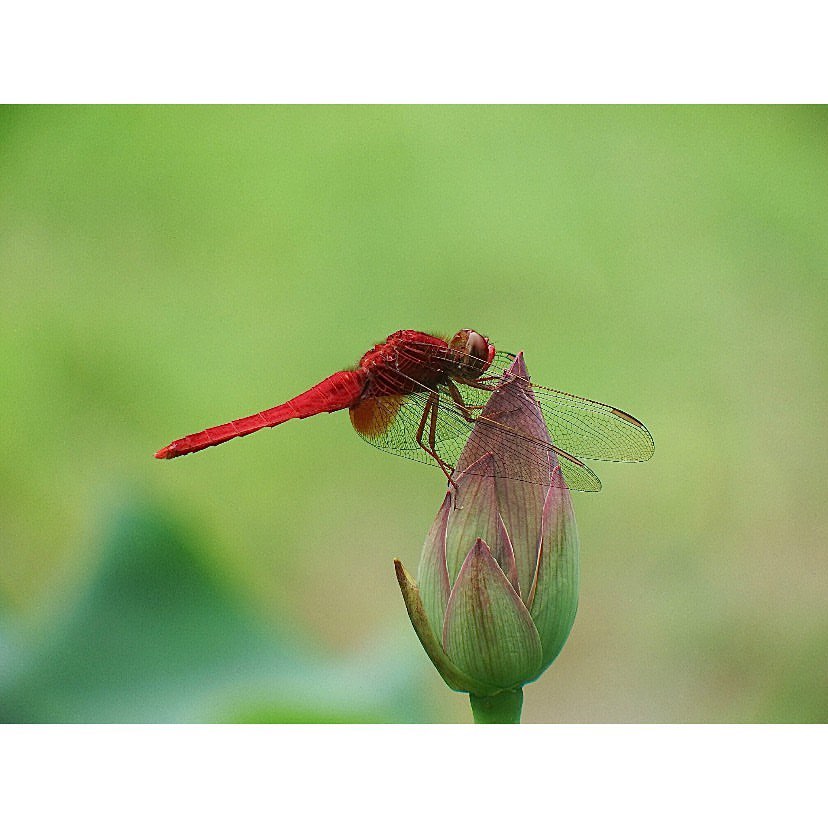
Distribution and Habitat
The Red Dragonfly is widely distributed across southern and central Europe, including the Mediterranean islands, the Middle East, and parts of southwestern Asia, such as Sri Lanka, India, and Mongolia. Originally prevalent in southern Europe, its range has expanded northward in recent decades. It is also present in the Madeira and Canary Islands and is believed to be the only member of the Libellulidae family inhabiting the Azores.
Like other dragonflies, it relies on aquatic habitats for breeding. However, as a migratory species, it is often found far from water, including over coastal and open marine areas.
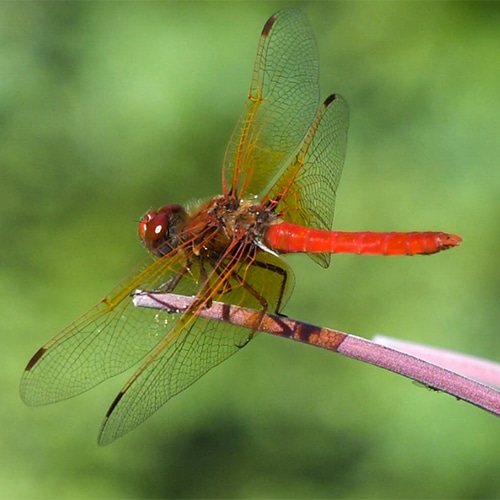
Behavior
This species remains active year-round in Mediterranean and southern regions, though its primary flight period spans from May to October, tapering off as winter approaches. The Red Dragonfly is territorial, with males frequently observed perching in dominant positions. After mating, the pair flies in tandem as the female lays eggs. During oviposition, the female repeatedly dips her abdomen into the water to deposit eggs.
Unlike many insects, dragonflies do not undergo a pupal stage. Instead, they transition directly from larva to adulthood. The Red Dragonfly can complete its entire life cycle in under three months, allowing multiple generations to emerge within a single year. Adult specimens are known to reach speeds of up to 56 km/h.
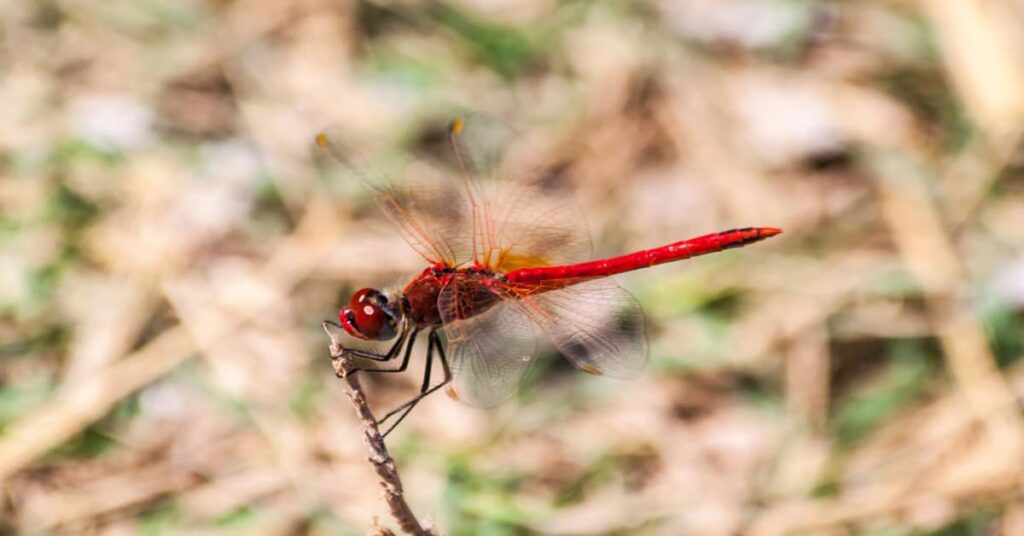
Diet
Like its relatives, the Red-Veined Darter is an adept and voracious predator. Adult dragonflies feed on a diverse range of insects, including mosquitoes, ants, flies, fleas, and butterflies, occasionally preying on smaller dragonflies. Their larvae, equally carnivorous, thrive in aquatic environments, consuming tadpoles, fish eggs, small fish, and mosquito larvae. Their lower jaw, or labium, is typically tucked beneath the body but can extend rapidly to seize unsuspecting prey, aided by specialized hooks.
Symbolism of Red Dragonflies
In urban Australia, particularly in the south, people might rely on the calendar to determine the season. For instance, if the date reads March 1st, it signifies the arrival of autumn. However, apart from donning a warmer layer, such seasonal transitions seldom influence human behavior. Many remain disconnected from the direct rhythms of nature.
By contrast, plants, animals, and fungi respond dynamically to environmental shifts. Changes in temperature, moisture, daylight duration, and intrinsic biological factors dictate their transformations—fruits ripen, animals reproduce, and certain species undergo metamorphosis or disappear.
In the Fitzroy region, temperature variations throughout the year are relatively minimal by southern standards. However, precipitation patterns fluctuate dramatically, with the majority of rainfall concentrated in the brief but intense summer wet season. Water plays a crucial role in the dragonfly’s lifecycle, as it spends a significant portion of its existence submerged as a predatory nymph, or naiad. Upon reaching maturity, it emerges from the water, its exoskeleton splitting to reveal a newly formed dragonfly—initially pale and crumpled, but soon airborne after expanding and drying its wings in the sunlight.
Fun Facts About Dragonflies
Dragonflies rank among the most precise hunters in the natural world. To put this into perspective, a lion may successfully capture its prey only twice in ten attempts, whereas a dragonfly boasts an astonishing success rate of nine out of ten. This remarkable efficiency is due to their enormous, multifaceted eyes, which grant them nearly 360-degree vision. Voracious predators, dragonflies feast on flies, mosquitoes, and virtually any other insect they can seize.
Beyond their hunting prowess, dragonflies are extraordinary fliers. Unlike most insects, whose wings move in tandem, dragonflies possess independently controlled wing pairs. This anatomical advantage allows them to maneuver with unparalleled agility, flying forward, backward, and even upside down. They can hover effortlessly and pivot instantaneously, making them among nature’s most adept aerial predators.
Despite myths and superstitions, dragonflies are entirely harmless—rest assured, they will not sew your lips shut for telling a lie! They lack stingers and pose no threat to humans.
Ecologically, dragonflies play a crucial role, serving as an essential food source for a variety of creatures, including fish, frogs, spiders, and birds.
The Red Dragonfly – A Symbol of Eternal Love and Death
The dragonflies on my farm are typically deep shades of black, blue, and green. Capturing an image of a red dragonfly was an extraordinary and rare opportunity, as they are uncommon in this region.
Good and Bad Omens
Red dragonflies are seldom seen, making their appearance all the more significant. Intriguingly, they often emerge during periods of loss and transition, creating an enigmatic paradox—their delicate beauty juxtaposed against moments of sorrow. Their symbolism intertwines both fortune and foreboding: they represent eternal love, yet also serve as harbingers of death. This duality mirrors the fundamental contrasts of existence.
The red dragonfly’s presence at moments of passing suggests a deeper, spiritual connection—a reminder that death is merely a transition, dissolving the illusions of life and leading us back to a realm of infinite love. In this way, their symbolism is not one of finality, but of transformation.

